Which is the best jobsite table saw? I’m comparing the Bosch 4100-10 with the DeWalt DWE7491RS.
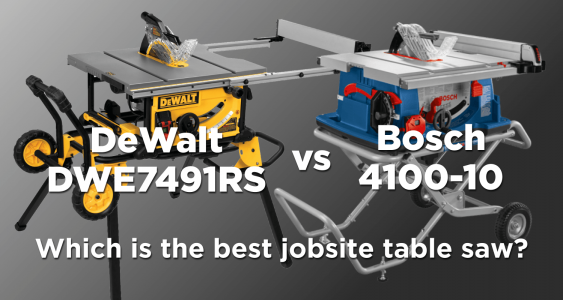
A good worksite table saw is a reliable, versatile tool. Their portability makes them great for moving from job site to job site, and they store easily for those needing a minimalist table saw for a home woodshop. Whether you’re a contractor or a hobbyist, a jobsite table saw is an excellent tool to have in your arsenal.
Two of the most popular jobsite saws on the market today are the Bosch 4100-10 and the DeWalt DWE7491RS. Both are similarly sized, powerful and have a wheeled stand.
But which one should you get? In this article I’ll compare them side by side to find out which is the best overall, and which one provides the best value for money.
In terms of size and portability, the Bosch 4100-10 wins hands down. This saw is a third lighter than the DeWalt, weighing in at 60 pounds. The DeWalt is still a highly portable saw, able to pack down and go relatively smoothly, just not as quickly as the Bosch. The Dewalt weighs 90 pounds, making transportation a bit more complicated.

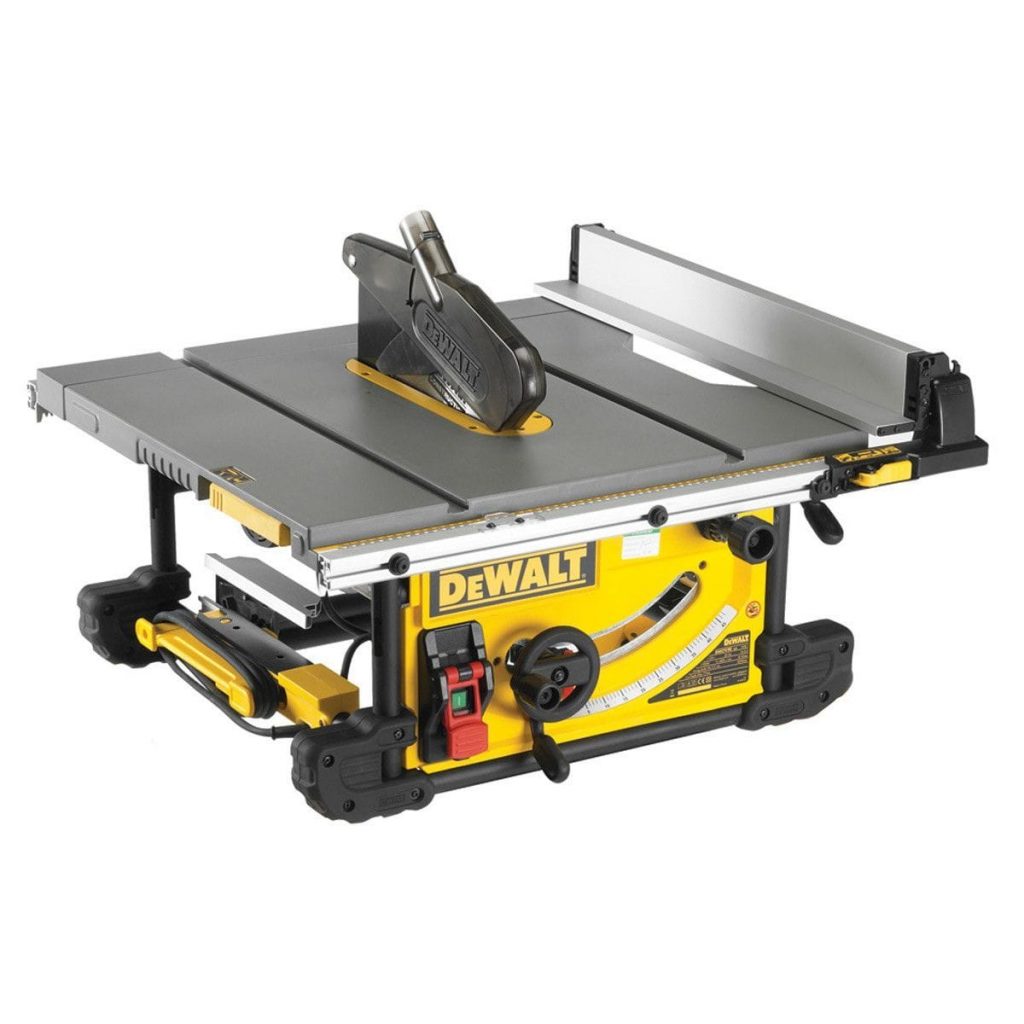
Both of these saws accommodate 10” blades and can be adapted to use dado blades with a special insert, purchased separately (for example these from Woodcraft). Each of these saws comes complete with a 24-tooth ripping blade to get you on your way to completing your first project.
The saws are on equal footing for a 90° cut, each with a cutting depth of 3 ⅛”. When it comes to 45° cuts, the Bosch offers ¼” more depth, coming in at 2 ½” with the Dewalt trailing at 2 ¼”, meaning the Bosch will handle marginally thicker materials better.
Both of these saws have a similar work area if you go by the numbers. The DeWalt has an overall work area of 26 ¼” x 22”, and the Bosch features a slightly larger workspace of 29” x 21 ½”. This would give the Bosch 4100-10 a slight edge if it weren’t for DeWalt’s innovative fence design, which we’ll discuss later.
That fence design gives the DeWalt a clear advantage when it comes to rip capacity. The DeWalt 7491RS offers a right-side rip of 32 ½”, and a left-side rip of 24”. The Bosch unit comes in at 30” rip capacity on the right side, 8 ½” on the left. If you’re looking for a saw that can handle larger material, the DeWalt has the edge.
The DeWalt has a slightly larger ripping capacity, but both the Bosch and DeWalt are able rip 4 ft plywood sheets in half.
The two saws sport 15-Amp (~1800W at 120V) motors, with the Dewalt having a slightly higher top speed of 4,800 RPMs. The Bosch is a bit slower, but I have to say I’m a big fan of Bosch’s “soft start” feature. This smart circuitry manages the power load into a more gradual startup curve, meaning it won’t trip a circuit breaker in your home or worksite. This is especially helpful if you’re running a shop vac at the same time.
Both saws are equally powerful, but Bosch has a slight edge thanks to its soft-start feature.
Stands have come a long way. If you need a great example, look no further than Bosch’s innovative “gravity rise” system. I find the Bosh pivot system more comfortable to use than the DeWalt’s four-leg design, giving the 4100-10 the edge when it comes to portability.
With the new 4100-10 upgrade compared to the old 4100-09, Bosch has also made the stand even lighter by cutting its size by 2 inches. This makes it even more portable.
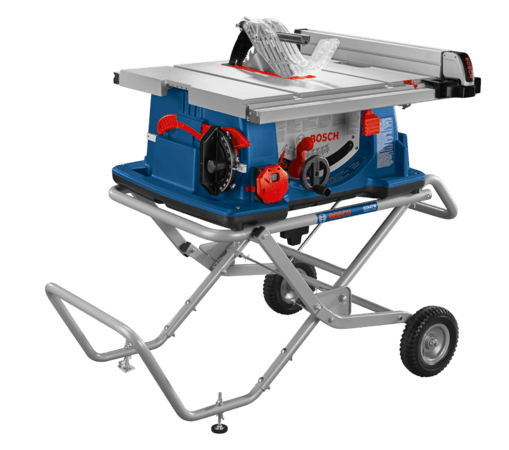
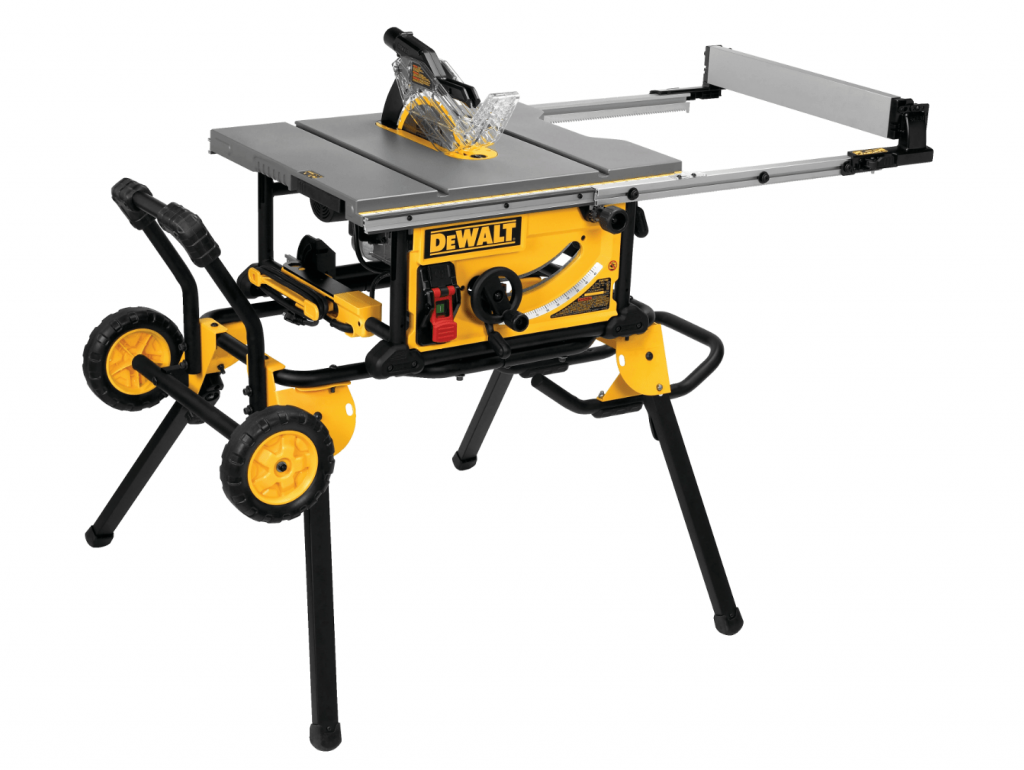
The DeWalt stand may be slightly harder to deploy, but I feel it is worth the effort, as it provides a sturdy, sure-footed platform. It lacks the ease of the Bosch system, but it is much simpler in terms of design, using simple hinges and ball locks instead of pivot points.
It’s also comforting to know that neither of the DeWalt’s two castors are in contact with the ground when the saw is in use. The outward angle DeWalt mounted each of the four legs makes for a stable work area, lessening the chance of the saw becoming off balance when handling larger materials.
If you’re moving your saw around regularly, then the Bosch gravity-rise system is superior. It’s lighter and easier to use. If you don’t move that often, the DeWalt’s rolling stand also works well and could be slightly sturdier once actually set up.
Between the Bosch 4100-10 vs Dewalt 7491RS, I’ve found that the miter gauges on both these saws have some issues, and other users have voiced their opinion that the stock miter gauges don’t fully meet their expectations. There are workarounds, like the technique in the video below, but it isn’t a long term fix.
Both miter gauges have issues. Pairing either of these saws with an aftermarket miter gauge is a big plus.
The rack-and-pinion fence on the DeWalt gives this saw repeatable accuracy, cut after cut. There’s also a fine adjustment knob for precise adjustments. The DeWalt integrated fence uses a unique extending design, extending out to allow for its 32 ½” ripping capacity.

The Bosch fence is no-frills, and like so many other design elements of the Bosch, it aims to save weight and enhance portability. This fence doesn’t feature any bushings, rails, or rollers, meaning it can bind up when making adjustments. You’ll need to apply equal pressure to either end of the fence when adjusting it to avoid this problem.
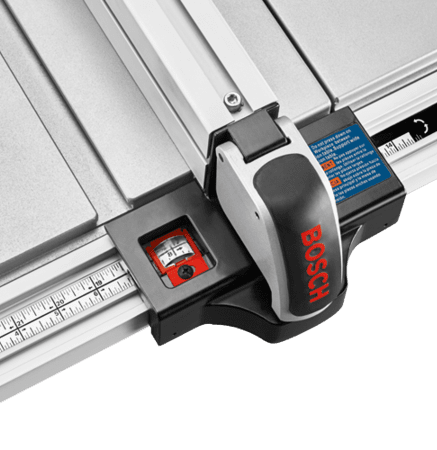
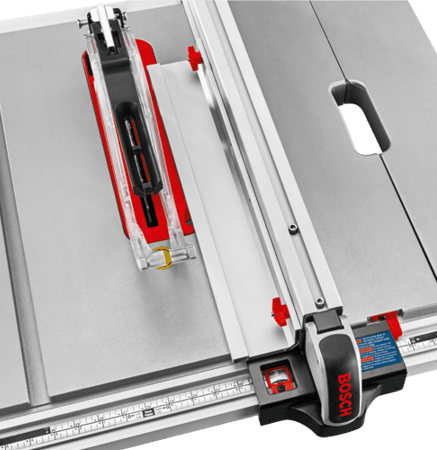
If you work with this tool often, you’ll learn to work around the shortcomings of the Bosch fence. If you are using your saw less frequently or just want to get the most precise cuts you can out of a portable table saw, the DeWalt offers one of the best fence systems I’ve seen.
The rack and pinion fence on the DWE7491 is superior thanks to its high accuracy and easy fine adjustment.
Now that we have broken down the specifics, which is a better buy overall?
If I had to pick which of these two saws was the best tool overall, it would have to be the DeWalt 7491RS. I love DeWalt’s innovative fence design, which makes narrow cuts and wide rips a breeze. I also just like the overall build quality of the DeWalt. The built-in stand, as well as the saw body itself, just seem more rugged and stable.
Type of machine
Table Saw
Designed in
Germany
User rating (1)
Production status
New
The Bosch lacks some of the DeWalt’s ruggedness, but it’s still a highly capable saw. It’s also quite a bit less expensive, making it my top choice for those operating on a budget. If you’re looking for a great value for your money, it’s hard to go wrong with the Bosch 4100-10.
If you’re looking for even more information about these two saws, I can strongly recommend watching the two video reviews below, both by actual users who know the machines in and out.
Which saw do you prefer? Why did you buy one over the other? Let us know in the comments below!
© Machine Atlas 2025
Your article states that the Bosh is best bang for the buck but according to your price points it is more expensive. Is there a typo.
Hi Myles, good point.
The prices shown above are current prices. Until about a month ago the Bosch was retailing about $500 – $600 and even for only $400 for a while. It seems the price has gone up significantly recently (at least on Amazon).
At this point in time the DeWalt is probably best bang for the buck.
Rob
I just purchased the Bosch. I also inspected the Dewalt but felt the quality was better on the Bosch. Both saws are good; at most stores equally priced . But I found the Bosch on sale for $500 (reduced from $600) for a two day sale. The Dewalt never went on sale. So for me the Bosch was best bang for the buck.
I wish to acquire a DeWalt DEW 7492 Table Saw with Dado Stack Blades capabilities with Power Specifications 240V, 50Hz, 1800W.
Can you connect me with a DeWalt Distributor in the United Kingdom